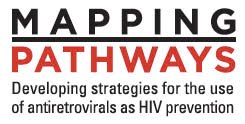via Science Speaks, by Antigone Barton

When he looks at what biomedical science can do in the next decade to prevent HIV transmission, Jim Turpin of the National Institutes of Health said, he thinks of the lyrics of a Timbuk3 song: “The future’s so bright I gotta wear shades.”
Turpin, program officer and branch chief in the Prevention Sciences Program in the Division of AIDS at NIH”s National Institute of Allergy and Infection Disease spoke this morning in webinar titled “The HIV Prevention Pipeline: A Future of Possibilities.” The webinar was sponsored by the International Rectal Microbicide Advocates (IRMA) and AVAC Global Advocacy for HIV Prevention.
After a series of disappointments in the quest for a vaccine or microbicide to prevent HIV transmission, the last two years offered hope, in strategies using antiretroviral medicine to prevent acquiring HIV, organizers point out. But, with a diversity of prevention needs and challenges among women and men worldwide still demanding answers, is that all there is?
Or, as Turpin put it, “Do we currently have what it takes to create a sustainable prevention pipeline?”
Read the rest.
[Content that is linked from other sources is for informational purposes and should not construe a Mapping Pathways position. Please look for us on Facebook here www.facebook.com/MappingPathways and you can follow us on Twitter @mappingpathways as well.]
When he looks at what biomedical science can do in the next decade to prevent HIV transmission, Jim Turpin of the National Institutes of Health said, he thinks of the lyrics of a Timbuk3 song: “The future’s so bright I gotta wear shades.”
By, which, actually, he means — don’t get blinded by the light; the search for answers will require focus.
“The challenge is not the lack of options,” he said, “but prioritizing the best options.”
“The challenge is not the lack of options,” he said, “but prioritizing the best options.”
Turpin, program officer and branch chief in the Prevention Sciences Program in the Division of AIDS at NIH”s National Institute of Allergy and Infection Disease spoke this morning in webinar titled “The HIV Prevention Pipeline: A Future of Possibilities.” The webinar was sponsored by the International Rectal Microbicide Advocates (IRMA) and AVAC Global Advocacy for HIV Prevention.
After a series of disappointments in the quest for a vaccine or microbicide to prevent HIV transmission, the last two years offered hope, in strategies using antiretroviral medicine to prevent acquiring HIV, organizers point out. But, with a diversity of prevention needs and challenges among women and men worldwide still demanding answers, is that all there is?
Or, as Turpin put it, “Do we currently have what it takes to create a sustainable prevention pipeline?”
Read the rest.
[Content that is linked from other sources is for informational purposes and should not construe a Mapping Pathways position. Please look for us on Facebook here www.facebook.com/MappingPathways and you can follow us on Twitter @mappingpathways as well.]

No comments:
Post a Comment